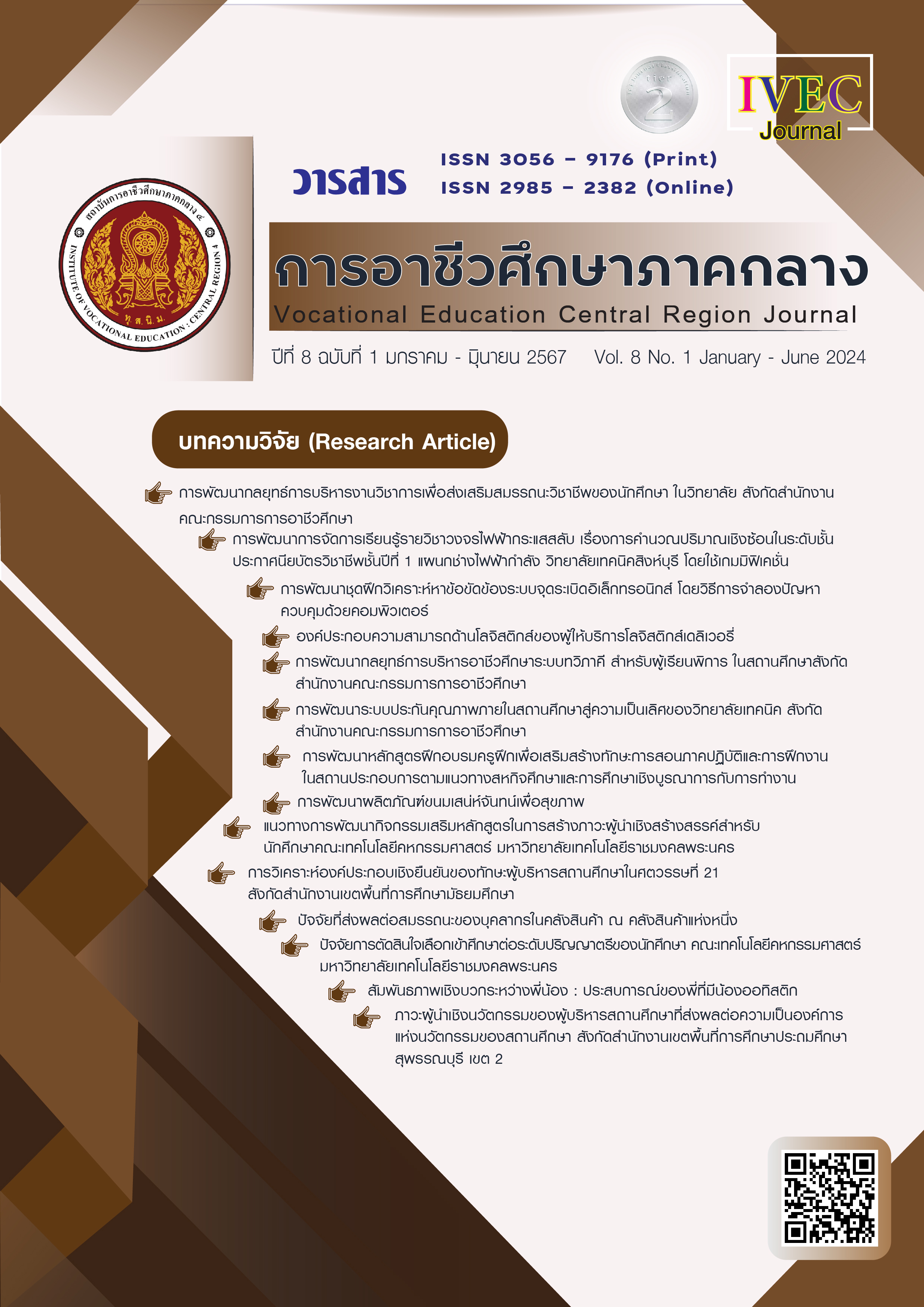Guidelines for the Development of Extra-Curricular Activities in Building Creative Leadership for Students of the Faculty of Home Economics Technology Rajamangala University of Technology Phra Nakhon
Main Article Content
Abstract
The objectives of this research aimed to study 1) the personal factors of students 2) the creative leadership of students 3) the relationship between personal factors and creative leadership of students and 4) development Guidelines for extra – curricular activities enrichment in building creative leadership. This research was conducted via questionnaire and analyzed by statistical devices including frequency, percentage, mean, standard deviation, and chi - square value. A stratified sampling method was used. The sample group consisted of 300 of 4 - year undergraduate students in 5 majors from the regular program, academic year 2023.The research used a purposive sampling method among the group of 5 university administrators and the university officers who are responsible for student
The result found that 1) the personal factor which included the 1st year female students, aged 19 – 20 years, majoring in Food and Nutrition. Status for participating in activities was general students and the most participated in extra - curricular activities were sports and recreations 2) Overall, the creative leadership of students was at the highest level 3) the personal factors and creative leadership of students had the same statistical relationship significantly at 0.05 level 4) Developmental guidelines for extra - curricular activities to create leadership for undergraduate students. Was to focus on organizing sports and recreations activities. Besides, leadership development activities should be organized using collaboration techniques to express attitude and perspective of the students. There should have been the creative thinking training, thinking outside the box, patience, solving various problems, and building the students’ self - confidence.
Article Details

This work is licensed under a Creative Commons Attribution-NonCommercial-NoDerivatives 4.0 International License.
|
บทความ ข้อมูล เนื้อหา รูปภาพ ฯลฯ ที่ได้รับการตีพิมพ์ในวารสาร การอาชีวศึกษาภาคกลาง ถือเป็นลิขสิทธิ์ของวารสารการอาชีวศึกษาภาคกลางหากบุคคลหรือหน่วยงานใดต้องการนำทั้งหมดหรือส่วนใดส่วนหนึ่ง ไปเผยแพร่ต่อหรือเพื่อกระทำการใด ๆ กองบรรณาธิการไม่สงวนสิทธิ์ ในการคัดลอกบทความเพื่อการศึกษาแต่ให้อ้างอิงแหล่งที่มาให้ครบถ้วน สมบูรณ์ สงวนสิทธิ์ โดย สถาบันการอาชีวศึกษาภาคกลาง 4 ที่ตั้ง 90 ถนนเทศา ตำบลพระปฐมเจดีย์ อำเภอเมือง จังหวัดนครปฐม โทรศัพท์ 034 242 856 , โทรสาร 034 242 858 ISSN : 3056-9176 (print) ISSN : 2985-2382 (online) |
References
จุฑาธิปต์ ทัพไทย. (2560). ภาวะผู้นำเชิงสร้างสรรค์ของผู้บริหารสถานศึกษา โรงเรียนอนุบาลสามเสน (สลากกินแบ่งรัฐบาลอุปถัมภ์) สำนักงานเขตพื้นที่การศึกษาประถมศึกษากรุงเทพมหานคร. วิทยานิพนธ์ ปริญญาศึกษาศาสตรมหาบัณฑิต สาขาวิชาการบริหารการศึกษาบัณฑิตวิทยาลัย มหาวิทยาลัยบูรพา.
เฉลิมพล มีชัย. (2562). การศึกษาความสัมพันธ์ระหว่างภาวะผู้นำเชิงสร้างสรรค์กับประสิทธิผลของมหาวิทยาลัย (รายงานการวิจัย). อุบลราชธานี: มหาวิทยาลัยการจัดการและเทคโนโลยีอีสเทิร์น.
ทิพย์วรรณ สุขใจรุ่งวัฒนา. (2557). การศึกษาปัจจัยที่ส่งผลต่อพฤติกรรมการเรียนที่ดีของนักเรียนชั้นมัธยมศึกษาปีที่ 3 สังกัดสำนักบริหารงานคณะกรรมการส่งเสริมการศึกษาเอกชน จังหวัดนครปฐม. วิทยานิพนธ์ ปริญญาศึกษาศาสตรมหาบัณฑิต สาขาวิชาพัฒนศึกษา บัณฑิตวิทยาลัย มหาวิทยาลัยศิลปากร.
ภาณุวัฒน์ ทวีกุล. (2560). ภาวะผู้นำเชิงสร้างสรรค์ของผู้บริหารฝ่ายกิจการนิสิตตามทัศนะของนิสิตและบุคลากรฝ่ายกิจการนิสิต มหาวิทยาลัยพะเยา. วิทยานิพนธ์ ปริญญาการศึกษามหาบัณฑิต สาขาวิชาการบริหารการศึกษา บัณฑิตวิทยาลัย มหาวิทยาลัยพะเยา.
พงษ์ศักดิ์ ทองพันชั่ง และ ธร สุนทรายุทธ. (2553). รูปแบบความสัมพันธ์โครงสร้างเชิงสาเหตุ ภาวะผู้นำการเปลี่ยนแปลงของอธิการบดีที่ส่งผลต่อประสิทธิผลของมหาวิทยาลัยราชภัฎ. การบริหารการศึกษามหาวิทยาลัยบูรพา, 5, (1), หน้า 76 - 88.
อัยรีน สมาแอ. (2562). การศึกษาภาวะผู้นำเชิงสร้างสรรค์ของผู้บริหารสถานศึกษา สังกัดสำนักงานเขตพื้นที่การศึกษาประถมศึกษายะลา เขต 3. วิทยานิพนธ์ ปริญญาศึกษาศาสตรมหาบัณฑิต สาขาวิชาการบริหารการศึกษา บัณฑิตวิทยาลัย มหาวิทยาลัยหาดใหญ่.
Basadur, M. (2008). Leading others to think innovatively together: Creative leadership. The Leadership Quarterly, 15, (2004), pp. 103-121.
Danner, S. E. (2008). Creative Leadership in Art Education: Perspectives of an Art Educator. Master’s thesis, Faculty of the College of Fine Arts of Ohio University.


